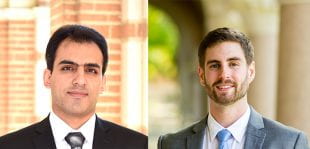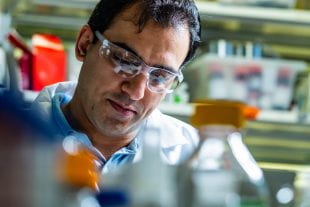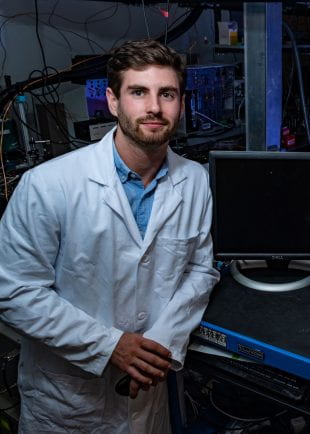Awards allow chemists Robatjazi, Swearer to pursue advanced research
They collaborated in the same laboratory, shared an office for years and competed for the same honor. Now, two Rice University alumni have each won 2019 Arnold O. Beckman Postdoctoral Fellowships in Chemical Sciences.
Hossein Robatjazi and Dayne Swearer, who worked together as members of Naomi Halas’ research group, are the first Rice graduate students to win the prestigious fellowships while pursuing their Ph.D.s.

Robatjazi (left) and Swearer (right) are the first two Rice graduate students to win the prestigious award while pursuing their Ph.D.s.
“We were surprised two people from the same lab won the award,” Robatjazi said. “Even though we were sort of competing, we shared proposals, ideas and feedback with each other.”
Beckman postdoctoral fellowships support advanced research in core areas of fundamental chemistry and help scholars transition from the role of mentored researcher to tenure-track faculty member.
“The Arnold O. Beckman Postdoctoral Fellowship is among the most prestigious awards that a young chemist can win,” said Seiichi Matsuda, Rice’s dean of graduate and postdoctoral studies, the E. Dell Butcher Chair in Chemistry, and a professor of biochemistry and cell biology. “While at first glance it might seem surprising that two people in the same lab won this very competitive fellowship, there’s a good reason for it. Dayne and Hossein are exceptionally talented, and Dr. Halas mentors her students to achieve at a fantastic level.”
Swearer and Robatjazi are among 15 researchers from 11 universities to win the coveted fellowships this year. Fellows receive $180,000 over two years for salary, fringe benefits and research expenditures.
Robatjazi, who earned his Ph.D. in electrical and computer engineering from Rice in May, is joining the chemical engineering department at the University of California, Santa Barbara. Swearer, who earned his Ph.D. in chemistry from Rice in May, is bound for the materials science and engineering department at Stanford University.
As members of the Halas Research Group, which studies nanoengineered photonics and plasmonics, Robatjazi and Swearer worked closely with one another on their research proposals.
“Hossein is my closest collaborator,” Swearer said. “We sit in the same office together, we work on the same projects together, we’re in the same research group and we’ve probably published about a dozen papers together. We each have our individual skills and complement each other, which I think is really rare. It’s great that we’ll be in the same Beckman cohort together, attending annual symposiums and continuing to collaborate together.”
Robatjazi will use his fellowship to focus on heterogenous catalysis, a crucial component for a range of technologies.
“Each year, trillions of dollars of value-added chemicals are produced using energy-intensive catalytic processes that rely on nanometer-sized transition-metal particles interfaced with typically metal oxide supports,” he said. “My ultimate goal is to develop novel photocatalysts to drive low-cost and efficient chemical conversions for current and future interests.”
Robatjazi plans to develop an experimental strategy based on in situ Kelvin probe force microscopy to provide mechanistic insights into the surface phenomena that govern heterogeneous catalysis at a single-particle level. A native of Iran, he came to Rice for its strong nanotechnology program.
“This fellowship is a big achievement,” Robatjazi said. “The fact that I could compete for a fellowship like this as an international student gives me a lot of confidence, because your ideas are only as good as how well you can communicate them.”
Swearer plans to use his fellowship to integrate optical microscopy and transmission electron microscopy to provide unprecedented spatial and spectral resolution of in situ chemical reactions as they occur on nanoparticle surfaces.
“Being able to take my own funding wherever I want gives me a lot of freedom, which is really exciting,” Swearer said. “I’ve always been interested in energy and developing technologies that can offset fossil fuels. The microscopy I have proposed would allow me to observe catalysts under real-life reaction conditions and see how they evolve over time.”
Swearer’s proposal represents an intersection of his scientific interests: studying heterogeneous photocatalysts with the high spatial and spectral resolution afforded by the electron microscope. At Rice he used light to drive chemical reactions, and at Stanford he will observe those reactions at the atomic level.
Swearer said his research will yield the first correlated images of site specificity and product selectivity in chemical reactions on nanoparticle surfaces. The results will shed light on the fundamentals of energy transfer in plasmonic systems and could have widespread significance for catalysis, microscopy and the understanding of dynamic chemical processes.
Robatjazi earned a bachelor’s degree in applied chemistry from Isfahan University of Technology in Isfahan, Iran, in 2009, a master’s degree in analytical chemistry from Sharif University of Technology in Tehran in 2011 and a master’s degree in electrical and computer engineering from Rice in 2016. Swearer earned a bachelor’s degree in chemistry and a master’s degree in organic chemistry from Drexel University in 2014.
The Arnold and Mabel Beckman Foundation provides grants to researchers and nonprofit research institutions in chemistry and life sciences to promote scientific discoveries, and particularly to foster the invention of methods, instruments and materials that will open up new avenues of research.



